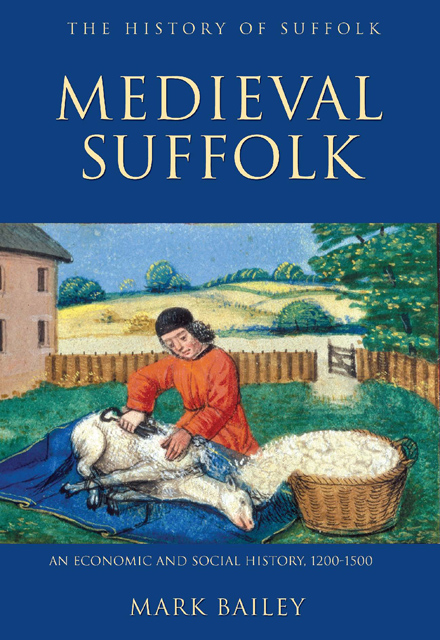Book contents
- Frontmatter
- Contents
- List of Plates
- List of Maps
- List of Tables
- Foreword
- Acknowledgements
- Note on Currency & Units of Measurement
- Abbreviations
- 1 Introduction
- 2 Landlords and their Estates, 1200–1349
- 3 Peasants and their Lifestyles, 1200–1349
- 4 The Agrarian Economy, 1200–1349
- 5 The Suffolk Landscape, 1200–1349
- 6 Towns and the Urban Environment
- 7 Commerce, Crafts and Industry
- 8 Pestilence, Rebellion and the Decline of Villeinage, 1349–1500
- 9 The Rural Economy, 1350–1500
- 10 ‘The World Turned Upside Down’: Rural Society, 1350–1500
- 11 Towns, Trade and Industry, 1350–1500
- 12 Conclusion
- Bibliography
- Index
5 - The Suffolk Landscape, 1200–1349
Published online by Cambridge University Press: 15 March 2023
- Frontmatter
- Contents
- List of Plates
- List of Maps
- List of Tables
- Foreword
- Acknowledgements
- Note on Currency & Units of Measurement
- Abbreviations
- 1 Introduction
- 2 Landlords and their Estates, 1200–1349
- 3 Peasants and their Lifestyles, 1200–1349
- 4 The Agrarian Economy, 1200–1349
- 5 The Suffolk Landscape, 1200–1349
- 6 Towns and the Urban Environment
- 7 Commerce, Crafts and Industry
- 8 Pestilence, Rebellion and the Decline of Villeinage, 1349–1500
- 9 The Rural Economy, 1350–1500
- 10 ‘The World Turned Upside Down’: Rural Society, 1350–1500
- 11 Towns, Trade and Industry, 1350–1500
- 12 Conclusion
- Bibliography
- Index
Summary
What did the landscape of Suffolk look like in the century and a half before the Black Death of 1349, and would it have been recognizable to the modern eye? Unfortunately, finding clear answers to such straightforward and interesting questions is problematic, because medieval sources do not describe explicitly how the landscape looked. However, they do provide partial information about how much of the land was managed. This enables us to recreate elements of the landscape, which was itself shaped by the particular ways in which local communities organized their arable fields, exploited other natural resources, such as woodland and marshes, and laid out their farms: this was especially true in an era when the economy was dominated by agriculture, and in a period of extensive colonization and intensive management of the land. Of course, the medieval landscape also owed some of its character to the imprints left by many earlier generations of settlers and agriculturalists, because thirteenth-century people were adapting some property boundaries and settlement patterns dating back hundreds of years. Indeed, historians have increasingly emphasized the importance of continuity in explaining the character and evolution of the British landscape, and consequently there are ample grounds for arguing that tracts of the medieval Suffolk landscape would have been readily recognizable to the modern eye.
The settlement pattern of medieval Suffolk was described in chapter 4. The earliest settlements tended to congregate in river valleys, but they were not planned nucleated villages like those in central England. By the thirteenth century valley settlements usually took the form of loosely integrated, polyfocal sites, while those on the plateaux above the river valleys, and those congregated around parish boundaries, comprised a mixture of greenside hamlets and isolated farmsteads. Towns were small by modern standards, containing hundreds rather than thousands of people, and so the extent of urban sprawl was limited: however, towns developed a distinctive topography during this period, when many marketplaces and street plans were laid out in ways that are readily identifiable today (chapter 6).
- Type
- Chapter
- Information
- Medieval SuffolkAn Economic and Social History, 1200-1500, pp. 90 - 115Publisher: Boydell & BrewerPrint publication year: 2007

